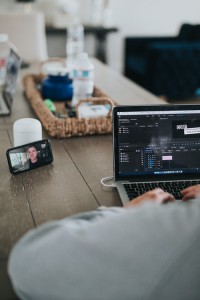Submitted by Professor Katie Ellis, Curtin University
Thursday, 21st May is Global Accessibility Awareness Day (GAAD). Now in its 9th year, GAAD aims ‘to get people talking, thinking and learning about digital access/inclusion and people with different disabilities’. The Curtin University Centre for Culture and Technology’s Digital Inclusion and Media Access program focuses research on digital access and inclusion for people with disability.
Our work advocates for inclusive design or the design of mainstream products or services to be used by as many people as possible without the need for special adaptation. The electric toothbrush is a key example of inclusive design. While it was originally designed to help people with physical impairments brush their teeth, the electric toothbrush has now been embraced by the mainstream. The touch screen on your smartphone is another example of disability innovation being used by the whole population.
Social, governmental and institutional responses to COVID-19 and preventing its spread has presented a fascinating social experiment in inclusive design and given us an opportunity to reinterpret findings of our key projects undertaken over the years.
We promote the redesigning of our digital systems so that they work for all potential users, including users with disabilities, and their varying language needs and diverse cultural preferences.
Captions and audio description are a key site of research and we have observed their increasing importance in both entertainment and education during the pandemic.
We have observed a shift in the public’s acceptance and use of closed captions on entertainment media. While they were previously considered a nuisance or visual clutter for people who can hear, they are now used by significant portions of the population binge-watching television.
Image: Mollie Sivaram/Unsplash
As Jason Kuhe observes in Wired, audiences are turning to captions to understand the soundtrack and dialogue of their favourite shows because ‘when you watch more TV, you miss more TV’.
I also wrote about this phenomena in my book Disability and Digital Television Cultures citing a research participant who found that her hearing housemates always left the captions on the television even if they had not been watching television with her.
I live with people whose English is their second language and so [captions] can be easier for them … I think it helps them learn English as well.
Just as captions provide accessibility for people who are deaf or hard of hearing, audio description is a narrative audiotrack describing important visual elements of a television show, movie or performance that provides access for people who are blind or have low vision.
In our project Audio Description in Australia we sought out to discover whether sighted people saw any benefit to audio-described content in the same way that hearing audiences have with captions.
Our sighted participants did find value in this feature highlighting the benefits of audio description when multitasking during daily activities. Multitasking was described by some participants as being able to enjoy television when screen visibility is obscured, or their attention is divided, with one saying:
For me personally it reduces the reliance on the visual aspect of the shows to follow what is going on, making it easier to follow when I’m trying to do things while watching.
I think it opens up more opportunities. Previously I would have only watched a show if I were able to actually give my attention to the screen, however this would allow me to divide my attention and multitask.
Audio description was also seen as a way to make visual media more accessible when mobile and/or unable to reliably focus on a screen, for example during hands-on activities that required intermittent–ocused attention. These included cooking, practising a musical instrument, caring for children and crafting.
Video on demand subscriptions have skyrocketed during COVID-19 as people seek out home-based entertainment. With attentions divided between work, study and domestic duties, the captions and audio-described content on these sites are finding new audiences and new affordances.
Captioned online lectures improve also grades when attempting to study from home when other distractions compete for students’ attention.
As the coronavirus spread around the world, quickly becoming a global crisis, schools, universities, and workplaces were forced to change their practices with little notice. Flexible workplaces and accessible digital environments have been key to our quarantine lives.
In the university context, students stopped attending classes on campus, everything went online. This is less of a massive change than a few steps closer to the direction higher education has been headed for some time.
In the months prior to the coronavirus outbreak we interviewed 53 students who had enrolled in 22 online units about their uses of captions in online lectures. While some of these students identified as having hearing impairments or sensory processing difficulties, the majority were distance education students seeking out any tool they could to improve their learning.
We discovered that these students were also multitasking while accessing lectures and used captions as a way to retain focus and improve clarity. These students had diverse learning styles and saw captions as a learning tool that could be used alongside a variety of other learning tools.
The comments made by participants were all made pre-COVID-19 but show just how useful captions would be for students learning from home during a pandemic:
As I am an online student, all of my lectures are online. I sometimes view them multiple times. I will stop the lectures if required while I am taking notes, and sometimes replay sections if I have lost my focus, missed the main points or have difficulty understanding what the lecturer is saying. I usually watch/listen to the lectures in our home office which is separated from the rest of the family, however, I can be interrupted by the teenagers living in the house if they want attention.
[I prefer] captions over sounds. With sound/audio, some accents can be hard to distinguish words. Some lecturers have monotone voices and can make a subject quite uninspiring. Audio is harder to use at night while Husband is sleeping and I want to study.
Image: Nathan Dumlao/Unsplash
Although we are now in an opening up process in Western Australia, we will be forever changed by the mandate to stay home to flatten the curve. Work and study-from-home options must remain available, and for these to be effective, they must be accessible. Talking, thinking and learning about digital access and inclusion, and people with different disabilities is key to ensuring we get this right.
_________________________________________________________________________________________________________________

